Flash choices for the Alpha DSLRs
TESTING the flash options most widely sold for the Minolta/Sony unique hot shoe system became a necessity after the launch of the Alpha 100. Despite the reliability of automatic TTL off-the-film flash metering ever since Minolta first introduced it with the Auto Electroflash PX series in 1981, things began to go wrong with the shift to digital SLRs.
It is impossible to measure flash in real time from the image formed on a CCD sensor. The sensor, unlike film, has a glass cover sheet and does not reflect light in a diffused way. This change broke the system, forcing Minolta to use a technology introduced some years earlier to give more accurate results in difficult conditions – Pre-Flash TTL with or without ADI (Automatic Distance Integration) telling the flash computer the actual focus distance.
The pre-flash was always measured in the camera prism, and this was possible with DSLRs. However, only flash units with (D) in their model name would give the correct pre-flash intensity and ADI control. In theory older flash units from the ‘xi’ series should have been able to do so, but Konica Minolta chose to lock these out from auto operation. They will fire on digital cameras, but only at full power. It is possible to modify earlier flash units by adding a controller chip – see http://www.voitzsch.net/flashconv_en.shtml – but we do not advise this type of surgery with high voltage electronic gear.
From the start, there have been issues with brand new 5600 HS(D) flashguns giving under or over exposure with different Konica Minolta 7D and 5D bodies. The correct procedure, if your flash consistently gives poor exposure in straightforward situations, is to have the flashgun and camera calibrated together by JP Service Solutions, the official repair facility in the UK, or your regional Sony authorized repair shop for KM products.
Fewer cases of the 3600 HS(D) producing poor exposure have been noted, and the pop-up flash generally produces good results.

The new Sony HVL-F56AM and HVL-F36AM units are nearly identical to the 5600 HS(D) and 3600 HS(D). Generally, they are proving better calibrated for use with the DSLR bodies out of the box and prices have been reduced recently. They are suitable for older Minolta and Konica Minolta cameras as well as the Alpha 100. In this article, I am not looking at the new Sony units, like the HVL36AM unit above. This is the new version of the 3600HS(D). If you experience consistently wrong exposure, they can be calibrated just the same way as the earlier Minolta and Konica Minolta versions.
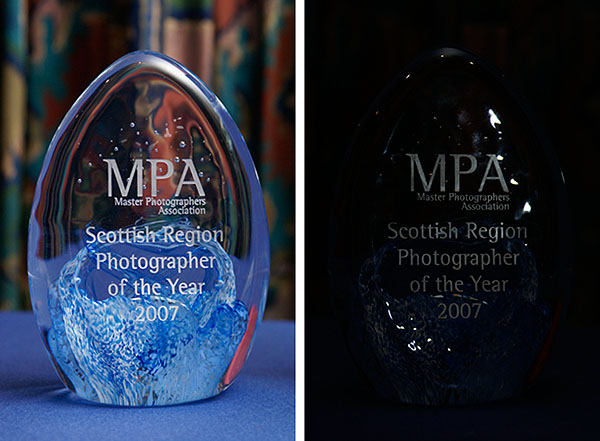
TTL pre-flash metering, with or without ADI, seems to be very sensitive to reflective highlights in the shot. It can be affected by something like a white shirt which coincides with the focus-point of the AF system and cut the exposure by two or three stops. We therefore recommend always checking your digital shot after taking it. When using bounce flash, this tendency is reduced, because the flash is not aiming directly at silver, glass, chrome, or bright white parts of the scene. However, tilting the bounce flash head forward a little (as many will do) can allow some direct light to reach the subject, and it only takes a very small reflection from this to kill a shot completely. The two pictures above were taken one after the other. They are from JPEGs, not raw, unadjusted. The good exposure had the bounce head aimed dead vertically at the ceiling above the camera. The dark shot had it tilted at 45 degrees – clearly enough for some direct light from the flashtube to strike the glass trophy. Disaster!
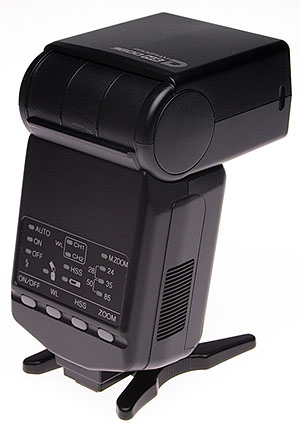
The 3600/36 has no flip-out wide angle diffuser, and the bounce head does not rotate. This makes it unsuitable for bounce shots in portrait (vertical) format unless you remove the flash from the camera and use wireless control via the pop-up flash. It also can not cover 17mm (on film) or 11mm (on digital) wide-angle direct flash shots without fitting a separate wide-angle panel (mine, like so many, is missing because the vendor of a used unit either didn’t find it, or was unaware it existed). There is no manual control and it’s not all that much smaller than the 5600. The bounce head does not lock, which in some ways is good, as you can flip it up quickly. Those lock buttons are a nuisance sometimes.
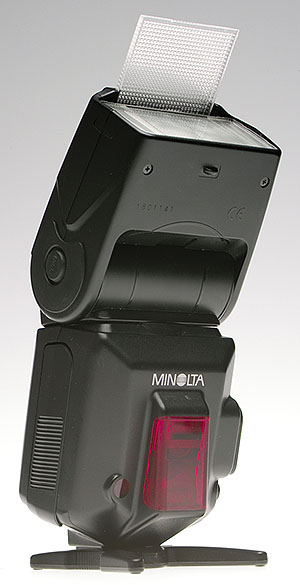
The 5600/56 is a far more versatile flash, with excellent rear controls including manual flash power even on cameras which don’t support this via their own menus (the 7D does).
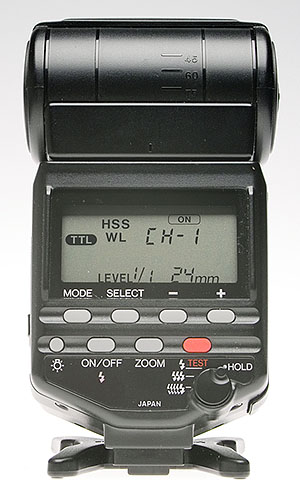
The flash head can be rotated as well as angled, allowing vertically held bounce shots, and there is a flip-out 17mm diffuser which can also be extended to use as a bounce fill reflector. The 5600 accepts an external power supply, and has a connection for the Cable CD or EX allowing cabled multi flash control. All these extras make the apparently high price well worth the difference.
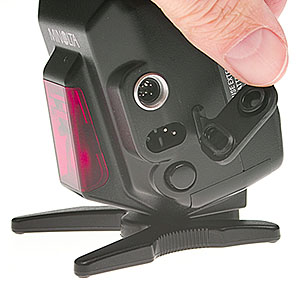
Above: the upper screw threaded port is for the cabled multiflash system and accessories, the lower socket is for AC mains or high capacity external battery pack powering.
Third party flashes
There are two independent flash makes you should consider for Dynax 5D, 7D or Alpha 100 use (they also work on the Dimage 5/7/A series). These makes are Sigma (Japanese) and Metz (German, also known as Mecablitz).
Sigma offers two different EF-500 units. The lower cost EF-500 DG ST lacks the wireless system or HSS but has ADI compatibility. Exposure with the EF-500 DG ST on camera, direct or bounced, proved to be around a stop under on all our three DSLR bodies.
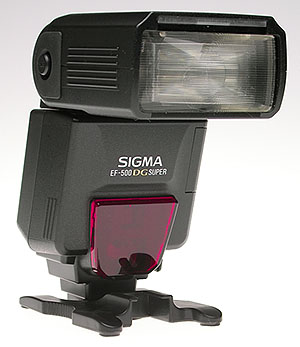
The EF-500 DG Super (above) is a far better option. This has HSS (High Speed Synch) burst mode, and Wireless. It is very easy to use and to make it ‘talk’ to Minolta or Sony models in a multi-head wireless set up. The rear controls are not as comprehensive and easy to navigate at the 5600, or as limited as the 3600. It also underexposed, but by switching to wireless mode and removing the flash from the camera this is quickly cured. Sigma will recalibrate either gun free of charge.
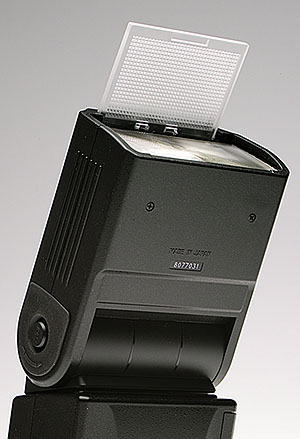
The EF500 Super flip-out wide angle diffuser can also act, like the Minolta/Sony version, as a bounce reflector.
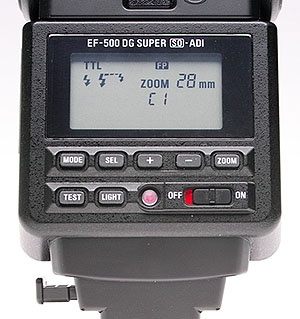
The DG500 Super has well laid out controls which are very easy to understand and use.
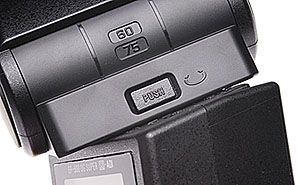
There is a separate lock button for rotating the bounce head of the Sigma DG Super, as well as one for tilt. This may be secure but it slows down rapid setting of the combined tilt and swivel often needed for bounce setup.
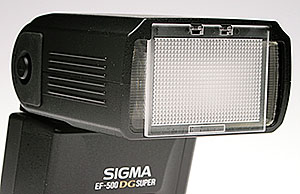
The wide-angle diffuser in normal position.
Compatibility ends with the flash shoe and the wireless mode, and Sigma flash units have no socket for Minolta/Sony cables, mains units or high power battery packs. Both have flip-out wide-angle diffusers which can be used as bounce fill reflectors, and have separate lock buttons for bounce tilt and head rotation. The only advantage the DG ST model offers is a truly simple user interface with Off, TTL, Manual Hi and Manual Lo powers. If you never want to mess with HSS, Wireless or multi-flash setups and just want a more powerful camera top flash for bounce shots it’s fine.
The problem encountered with both Sigma units was one of consistent underexposure. This can be corrected by Sigma and they only require the flashgun back to make the adjustment. It may not apply to all units sold as the default calibration can be changed to suit the most common camera model.
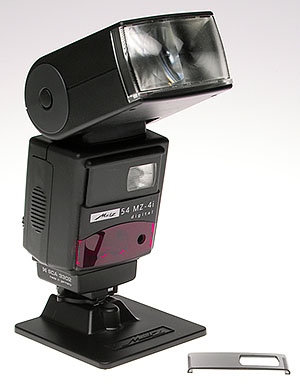
Metz (Mecablitz) make one current model in their SCA system which uses interchangeable base sections to fit different cameras.
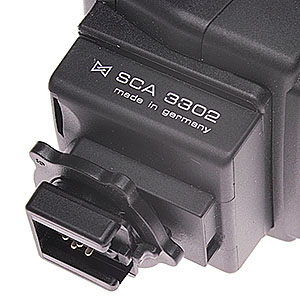
The Konica Minolta/Sony base unit is the SCA-3302 (above) and the gun is the 54MZ-4i, which supersedes an earlier 3i model.
This gun is by far the most fully featured, offering two things none of the others do – a twin flash design with fill-in, and a thyristor Auto mode which bypasses the camera’s pre-flash and TTL metering entirely.
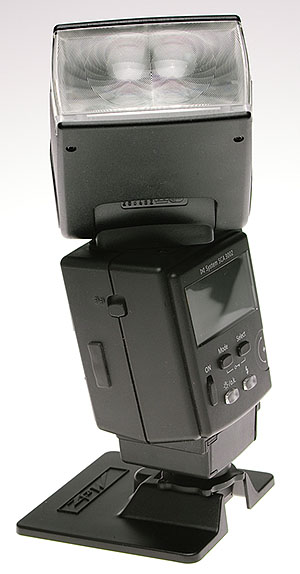
It has a single button bounce/rotate lock, like the Minolta and Sony, and a similar flip-out wide angle diffuser once again well suited for use as a bounce fill. However, the second flash tube which can be switched on or off as needed does this, adding bright catchlights to eyes and generally crispening up the look of bounce-flash pictures.
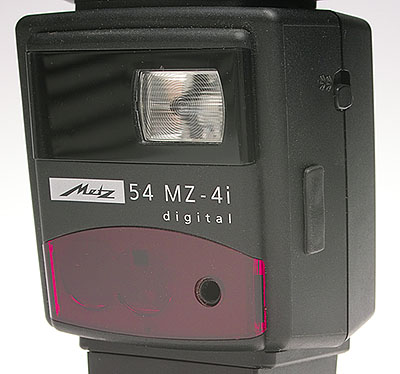
Covering the second reflector is a neutral density filter with a cutout. This can be flipped round to provide a 4X reduction in the fill flash level. It’s a bit of a nuisance and fell off repeatedly. It would get lost or damaged in daily use and is best kept safely off the gun.
![]()
The Metz user interface is not the most intuitive, relying on multiple button presses plus a thumbwheel to scroll through choices. It is more fully featured than the 5600, with its additional A mode. This does not mean ‘Auto’ in Minolta terms (flash switches on automatically when required) but A in the old thyristor-sensor autoflash sense.
We found the exposure with the 54MZ-4i to be rather ‘over’ with all bodies when using TTL pre-flash, better using A. There is no pre-flash with A, either, and as a result fewer cases of people blinking. This gun reminded me of why the old electric eye in the front of the flashgun is a very good concept to revive for the age of DSLRs. As long as it is aiming at the subject, it works better. All Metz results tended towards full exposure, ranging from correct to more than one stop overexposed.
For unlocking from the flash shoe, Sigma use a large plunger instead of the neat small button we are used to. Metz use a very crude screw-down thumbwheel, like the old sort found on regular flash shoes, which defeats the whole point of the superior Minolta shoe design.
Both Sigma and Metz ranges use hard switching for on and off – a sliding switch. Minolta and Sony use a soft switch, button press, with auto power off timeout.

From the left: mini Minolta, brass-tripod bushed dual purpose super Sigma, and clunky awful Metz. Flash feet, from ballet to hobnail boots.
All these guns come with tripod-mount ‘feet’ for standing the flash on a surface or screwing it to a tripod. The worst one is the Metz, a large ugly plastic square with a moulded thread. Next worst is the Sony/Minolta design, though it is neat and small. It’s a little too small and it has a plastic thread.
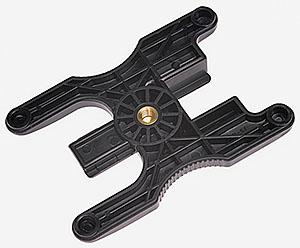
The winner is Sigma, with a very well designed foot capable of taking either Minolta or standard flash fittings, and an embedded brass tripod thread.
The exposure tests
The test was conducted using a Sony A100, SAL 18-70mm f/3.5-5.6 DT kit lens, and all five flashguns. Settings were multi-pattern (matrix) metering, pre-flash TTL, Fill-In mode, ISO 100 for direct, ISO 400 for bounce, lens at 50mm focal length, f/8. Hardly a single exposure is correct. Using ADI instead of pre-flash TTL actually made things worse, with darker results; using Centre Weighted metering improved darker results. Spot metering was not tested. The test was based on settings which gave the most satifactory general results with all the guns. When using one gun only, modified settings in many case would improve the result. These modifications to set-up would then bias against other units.
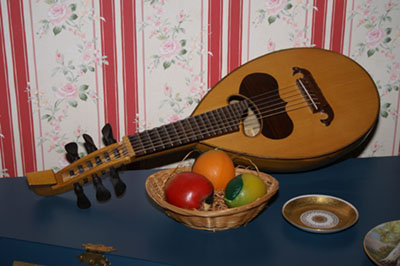
3600 HS (D) direct
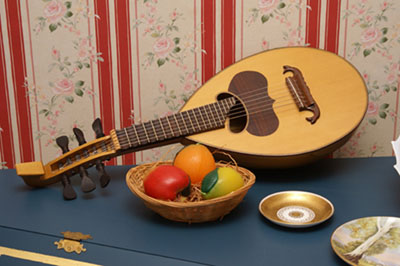
3600 HS (D) bounce
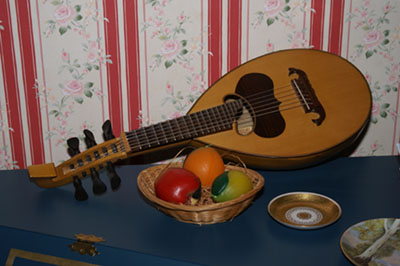
5600 HS (D) direct

5600 HS (D) bounce

Sigma EF500 ST direct

Sigma EF500 ST bounce
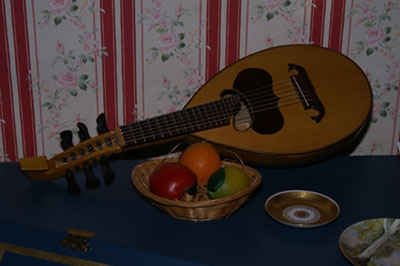
Sigma EF 500 Super DG TTL direct
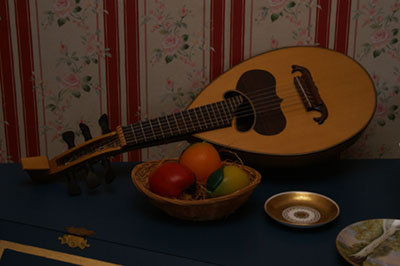
Sigma EF 500 Super DG TTL bounce
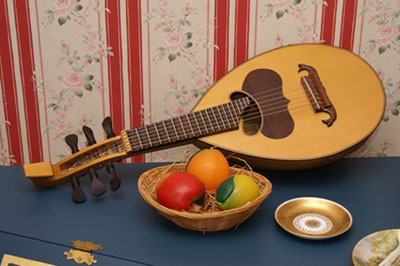
Sigma EF 500 Super DG wireless bounce
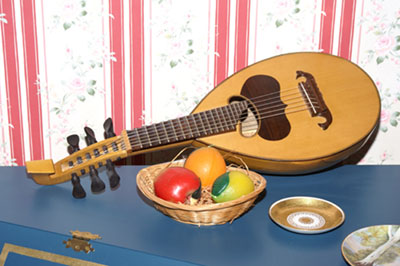
Metz 54 MZ-4i TTL direct
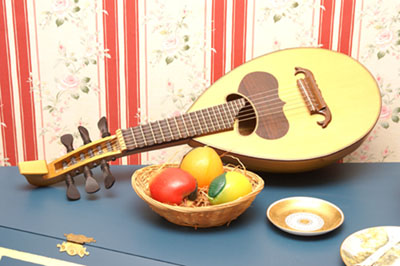
Metz 54 MZ-4i TTL bounce
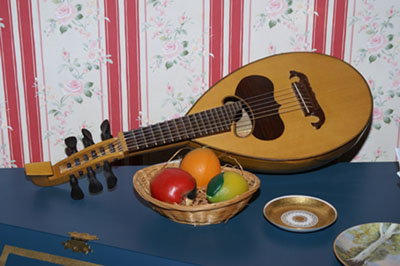
Metz 54 MZ-4i ‘Auto’ direct (thyristor eye cell metering)
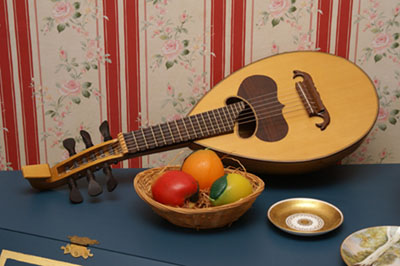
Metz 54 MZ-4i ‘Auto’ bounce
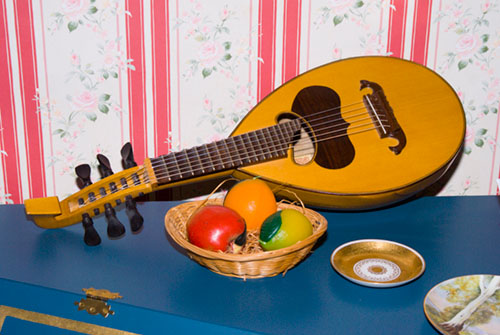
But finally, to show that not all is lost, here is the RAW file from the Sigma EF 500 Super DG TTL direct exposure converted from the Sony Alpha 100 raw file using Adobe Camera Raw. Dark JPEGs – disaster (though they can be lightened a lot). Dark .ARW file – not a problem!
Your choice
All the flashguns reviewed here are functional and good value, but performance varies as you can easily see even on this unchallenging subject (it’s a reproduction of an 18th century Lombard mandolino). It proved impossible to get the Metz, Sigma and Minolta flashes to agree on a three-head wireless set up using CH-1 but two Minoltas plus the Sigma, or two Minoltas plus the Metz, or Metz and Sigma controlled by the camera all worked.
You can safely add one independent brand gun to your armoury, but if you want two, stick to the same brand. Sigma offer recalibration of their guns if you find consistent wrong exposure, and Metz offer firmware upgrading of the shoe adaptor for the same reason. The current Metz version is SCA 3302 vM7 and any gun bought for Minolta/Sony should be identified as having an M7 adaptor, not earlier.
My favourite has to be the Metz 54MZ-4i for its extra features, despite the typical price of around £270-300 with the necessary Sony/Minolta foot. Beware all other Metz models which may be in shops and are marked as Minolta – they probably will be older stock, not digitally compatible. Intro2020, the importers, will tell you whether any model is 7D/5D/A100 compatible.
Value for money, the award goes to Sigma as the non-wireless ST model can be found for under £100. In terms of brand confidence, I guess that buying the real thing – whether used Minolta or new Sony – is always a safe decision and the exposures, while a bit dark, were most consistent.
The choice is out there and all these guns performed well in wireless mode where offered. For best flash exposure, remove your gun from the camera, control it from the pop-up, use wireless. Many exposure errors occurred with every gun on all three cameras in varying degrees in different situations. Results could be improved by switching to centre weighted or spot metering for some subjects.
Once you know the flashgun, and the way it behaves on-camera in exposure terms, it is possible in any case to compensate. But check the result every time!
– David Kilpatrick
This article is slightly amended from the Spring 2007 Photoworld magazine edition, which also reproduced all the test images. See our tests sooner – subscribe to Photoworld!
